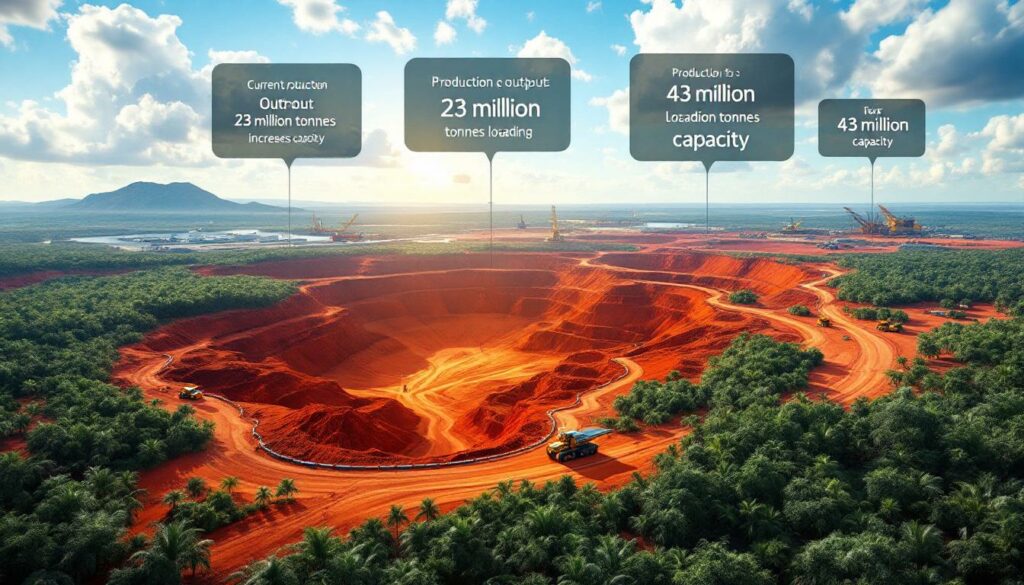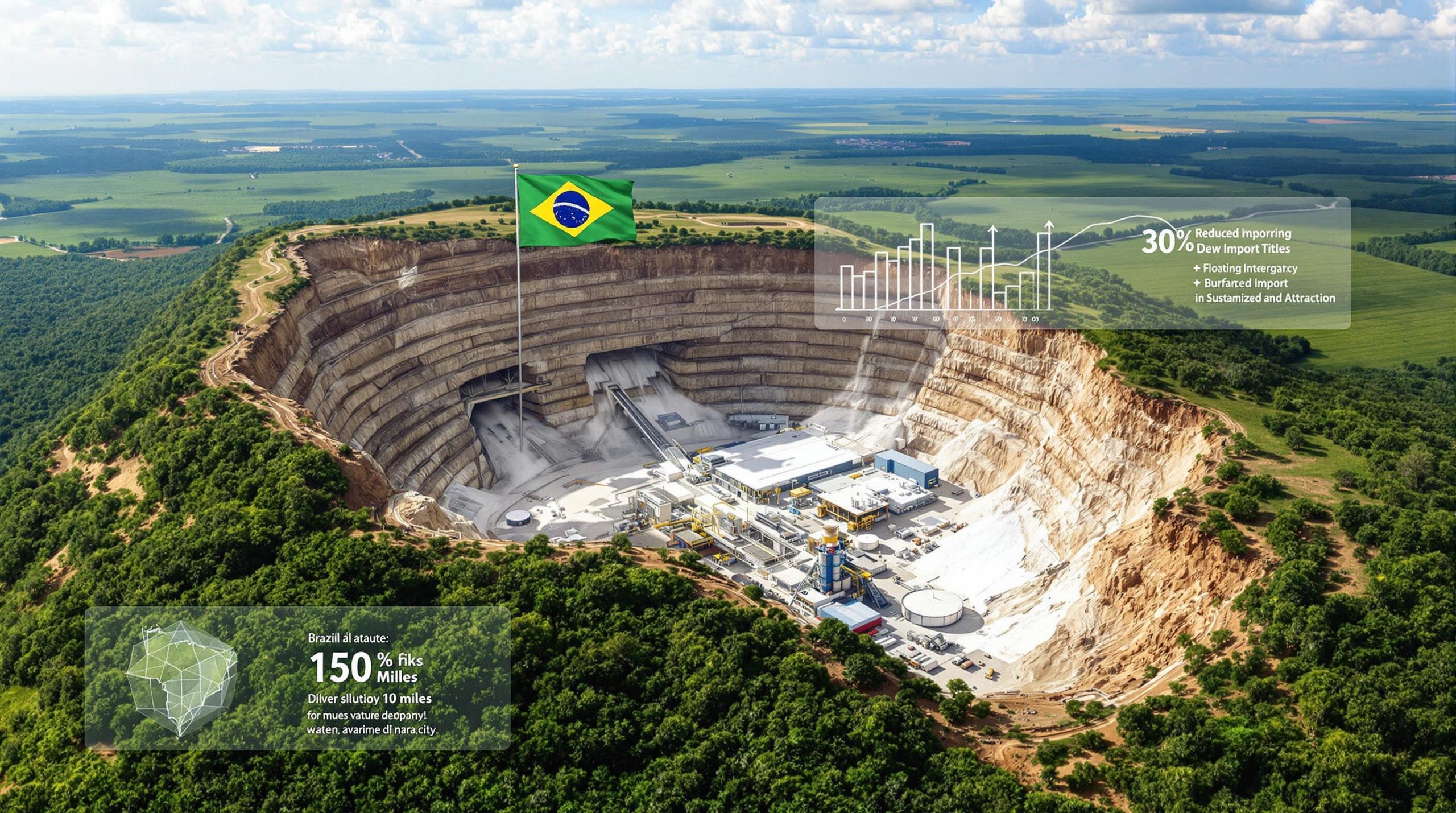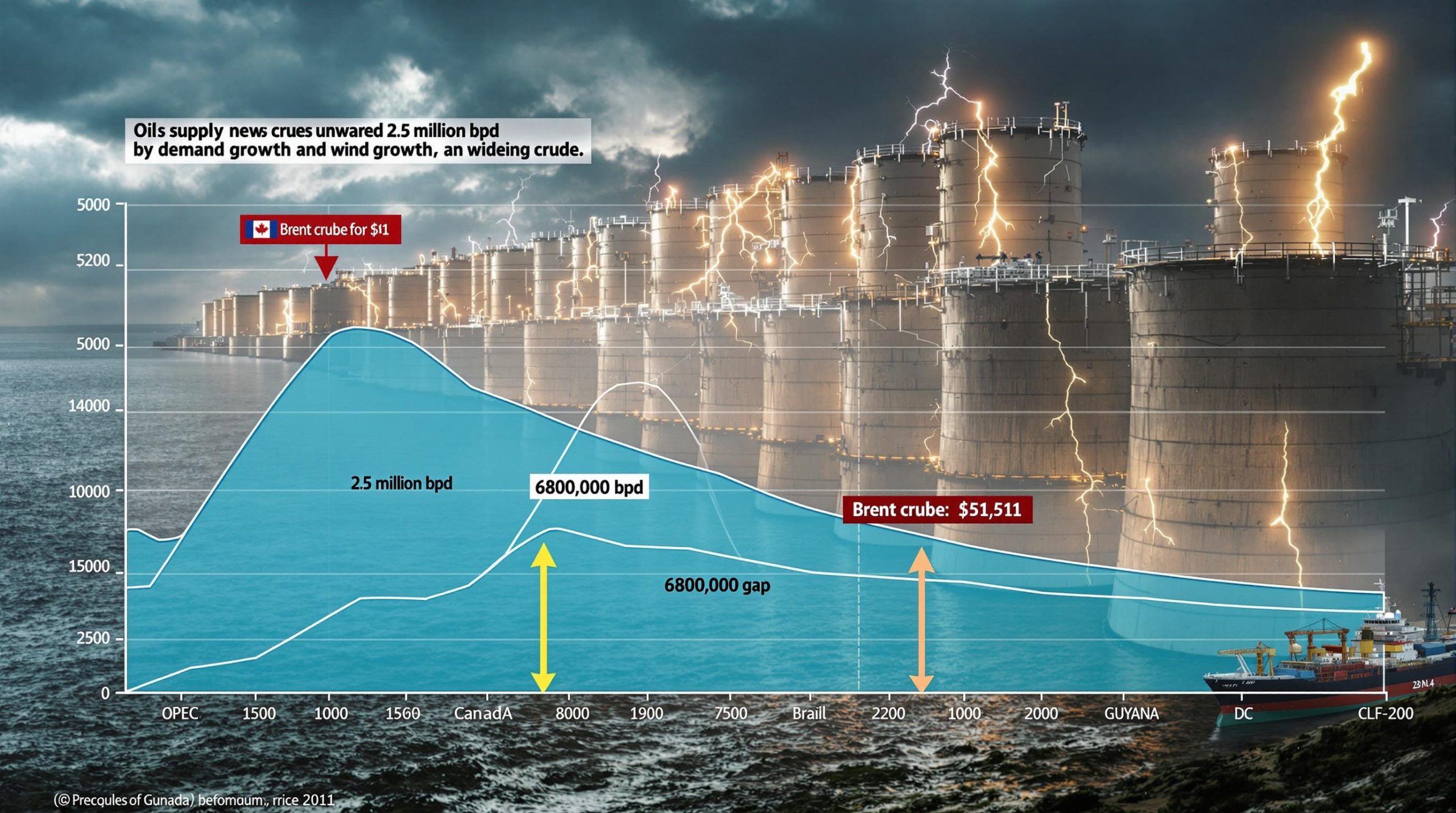What is the Kangwinan Bauxite Project?
The Kangwinan Bauxite Project represents Rio Tinto's strategic expansion of bauxite operations in Australia's Cape York peninsula. Located approximately 15 kilometers southeast of the existing Amrun mine in Far North Queensland, this development aims to establish a new mining center with expanded port facilities to maintain Rio Tinto's position as a global bauxite leader.
The project serves a critical purpose beyond mere expansion. As confirmed by industry analysts, Kangwinan is strategically timed to replace declining production from two aging operations reaching the end of their operational life: the Andoom mine in Cape York and the Gove mine in the Northern Territory. These established mines are expected to deplete their economically viable reserves by the late 2020s, making Kangwinan essential for continuity in Australia's bauxite supply chain.
Project Overview and Strategic Importance
Kangwinan represents more than just a new mine—it's a cornerstone of Rio Tinto's long-term strategy to maintain its competitive edge in the global aluminum value chain. Industry experts note that securing high-quality bauxite reserves is becoming increasingly challenging worldwide, with fewer undeveloped deposits offering the favorable combination of grade, volume, and accessibility that Cape York provides.
The project's significance extends beyond Rio Tinto's corporate interests. For Australia's resources sector, Kangwinan reinforces the nation's position as a reliable supplier of high-quality bauxite to global markets, particularly at a time when global mining landscape has highlighted the importance of secure supply chains for critical minerals.
Production Capacity and Infrastructure Plans
The scale of the Kangwinan project reveals Rio Tinto's confidence in long-term bauxite demand:
- Current capacity: 23 million tonnes annually from existing Weipa Southern operations
- Additional capacity: Up to 20 million tonnes from the Kangwinan project
- Total future capacity: Approximately 43 million tonnes annually
What sets Cape York bauxite apart is its exceptional quality profile. The region's deposits typically contain 50-55% alumina content with relatively low reactive silica, making them premium feedstock for aluminum refineries. This quality advantage allows Australian bauxite to command premium pricing despite longer shipping distances to key markets compared to competitors like Guinea.
The infrastructure development plan extends beyond mining operations to include:
- Expansion of Amrun port facilities with additional berths
- Construction of dedicated haul roads connecting mining areas
- Upgraded crushing and screening facilities
- Water management systems designed for tropical monsoon conditions
- Advanced dust suppression technology to minimize environmental impacts
Timeline and Development Status
The development of Kangwinan follows Rio Tinto's methodical approach to major project implementation, with clearly defined stages and decision gates. This structured timeline allows for thorough evaluation at each phase while maintaining flexibility to adapt to changing market conditions.
Current Progress and Early Works
Rio Tinto has already begun laying the groundwork for this significant expansion:
- Construction of a 250-room accommodation facility at Amrun Village to house construction workers is underway
- Initial access roads to the Kangwinan area have been developed
- Preliminary site preparation and exploration drilling to further define the resource body
- Environmental baseline studies are being conducted to inform future management plans
- Community consultation with local stakeholders has commenced
These early works represent a measured approach rather than a full commitment, allowing Rio Tinto to progress essential preparation while final investment decisions remain pending.
Decision Timeline and Production Forecast
The project's development schedule includes several key milestones:
| Milestone | Expected Date | Status |
|---|---|---|
| Initial feasibility studies | 2023-2024 | Completed |
| Early works construction | 2024-2025 | In progress |
| Final investment decision | 2026 | Pending |
| Main construction phase | 2026-2029 | Planned |
| First production | As early as 2029 | Planned |
| Full operational status | Early 2030s | Planned |
The 2026 final investment decision represents a critical juncture for the project. This timing is strategic, allowing Rio Tinto to assess the global aluminum market outlook following post-pandemic economic patterns and energy transition impacts on metal demand.
Mining industry analysts note that this timeline aligns with projected depletion rates at Andoom and Gove, creating a carefully orchestrated transition that maintains production continuity without gaps or overlaps that could affect market balance.
Economic and Employment Impact
The Kangwinan bauxite project in Australia's economic footprint extends well beyond the mine site itself, creating ripple effects throughout regional economies in Far North Queensland.
Job Creation Potential
Employment benefits from the project will be substantial:
- Construction phase: More than 800 jobs spanning roles from civil engineering to electrical installation
- Operational phase: Preservation of existing workforce from mines scheduled for closure, providing critical employment continuity
- Indirect employment: An estimated 3:1 multiplier effect for support industries and services
- Indigenous employment: Continued commitment to Aboriginal participation, building on Rio Tinto's existing 25% Indigenous workforce in Cape York operations
What makes these employment figures particularly significant is the geographical context. In remote communities like Weipa (population approximately 4,000), mining operations form the economic backbone of the region. The transition from existing operations to Kangwinan will help prevent the population decline and economic contraction often associated with mine closures in remote areas.
Regional Economic Benefits
Beyond direct employment, Kangwinan promises broader economic contributions:
- Local procurement: Opportunities for regional businesses to supply goods and services
- Infrastructure development: Roads and port facilities that benefit other industries
- Skills development: Training programs that enhance regional workforce capabilities
- Community investment: Continuation of Rio Tinto's community partnerships in health, education, and cultural programs
Economic analysts estimate that each dollar of direct mining investment in remote regions typically generates $2.50-$3.00 in broader economic activity, highlighting the project's importance to regional stability. Similar to the Julimar West Bauxite Project benefits, this development will strengthen local economies across multiple sectors.
"Mining projects like Kangwinan are essential economic anchors for remote communities. They provide not just employment, but the population base needed to sustain schools, healthcare facilities, and other essential services that make these communities viable." – Mining Weekly, July 25, 2025
How Does Kangwinan Fit Into Global Bauxite Markets?
The Kangwinan project must be understood within the broader context of global bauxite supply dynamics, where Australia competes with major producers like Guinea, China, and Brazil.
Strategic Replacement of Declining Assets
Kangwinan's development timeline is carefully calibrated to coincide with the expected depletion of resources at Rio Tinto's Andoom and Gove operations. This strategic sequencing aims to maintain consistent production levels while transitioning to new resource areas, avoiding market disruptions.
What differentiates this approach from typical mining developments is the forward planning horizon. While many mining companies operate on 5-7 year development cycles, Rio Tinto's bauxite strategy encompasses a 15+ year view, reflecting the long-term nature of aluminum industry investments and relationships.
Australia's Position in Global Bauxite Supply
Australia currently ranks as the world's leading bauxite producer, with approximately 110 million tonnes produced in 2023 according to USGS data. This represents about 28% of global output, positioning Australia ahead of Guinea (76 Mt) and China (66 Mt).
The competitive landscape is evolving rapidly, however:
- Guinea continues to expand production with Chinese investment backing
- Malaysia has limited exports due to environmental concerns
- Indonesia has implemented various export restrictions to encourage domestic processing
- Brazil maintains steady production but faces logistical challenges
Cape York bauxite offers several competitive advantages in this landscape:
- Quality profile: Higher alumina content (50-55%) than many competing sources
- Political stability: Australia presents lower sovereign risk than alternative sources
- Established infrastructure: Mature mining regions with ports, power, and logistics
- Environmental standards: Operations meeting stringent Australian regulations
These factors combine to make Australian bauxite particularly attractive to refineries seeking reliable, high-quality feedstock, despite the longer shipping distances to major markets in China and the Middle East. However, commodity market volatility continues to challenge producers in managing price risks.
Environmental and Cultural Considerations
Mining developments in Australia operate under some of the world's most comprehensive regulatory frameworks for environmental protection and cultural heritage preservation.
Indigenous Engagement and Cultural Heritage
A critical aspect of the Kangwinan project is ongoing consultation with the Wik Waya people, the traditional owners of the land. Rio Tinto has emphasized the importance of meaningful engagement following the company's widely criticized destruction of the Juukan Gorge caves in Western Australia in 2020.
The engagement process includes:
- Comprehensive cultural heritage surveys of the project area
- Participation of traditional owner representatives in project planning
- Development of cultural heritage management plans
- Implementation of chance-find procedures during construction
- Ongoing cultural awareness training for all site personnel
These measures reflect evolving industry standards that recognize Indigenous rights and knowledge as integral to responsible resource development. The process goes beyond mere consultation to seek genuine partnership with traditional owners.
Environmental Management Approach
While specific environmental management strategies for Kangwinan are still being developed, the project will build on practices established at Rio Tinto's existing Cape York operations:
- Progressive rehabilitation: Restoring mined areas concurrently with ongoing operations
- Water management: Sophisticated systems to handle the region's high rainfall (averaging 1,500mm annually)
- Biodiversity protection: Identification and preservation of high-value conservation areas
- Dust and emissions control: Real-time monitoring and adaptive management systems
- Waste management: Minimizing landfill through recycling and beneficial reuse programs
Environmental experts note that bauxite mining presents different challenges compared to other mining types. The relatively shallow nature of bauxite deposits (typically 1-2 meters below surface) means larger land disturbance footprints but less intensive excavation than deep mining operations. Furthermore, mine reclamation practices have evolved significantly, allowing for better environmental outcomes.
What Makes Kangwinan Strategically Important?
The Kangwinan project's strategic value extends beyond simple resource extraction to encompass broader industry dynamics and regional development goals.
Securing Long-term Bauxite Supply
For Rio Tinto, Kangwinan represents a crucial link in maintaining the company's integrated aluminum value chain. As one of the world's largest aluminum producers, Rio Tinto requires consistent access to high-quality bauxite to feed its refining and smelting operations.
Industry analysts point to several factors making bauxite security increasingly important:
- Refining investments: Aluminum refineries represent multi-billion dollar, decades-long investments that require assured raw material supply
- Quality specifications: Modern refineries are optimized for specific bauxite characteristics, making supply continuity valuable
- Disruptions in bauxite supply: Can trigger significant price spikes in aluminum markets
- Energy transition: Aluminum demand is projected to grow substantially for renewable energy infrastructure and lightweight vehicles
By developing Kangwinan, Rio Tinto not only replaces depleting assets but positions itself to potentially expand market share as global aluminum demand grows. This approach aligns with broader mining industry evolution trends toward securing critical mineral supply chains.
Regional Economic Stability
The economic importance of Kangwinan extends beyond corporate strategy to regional development:
- Population stabilization: Maintaining employment prevents outmigration from remote communities
- Service viability: Sufficient population base supports essential services like healthcare and education
- Indigenous opportunity: Continued employment and business development pathways for Aboriginal communities
- Diversification potential: Mining infrastructure can support development of other industries
For remote regions like Cape York, large resource projects often serve as economic anchors that make other activities viable. The continuity provided by Kangwinan helps prevent the boom-bust cycles that have historically affected mining communities.
FAQ About the Kangwinan Bauxite Project
When will the Kangwinan project begin production?
If approved following the final investment decision expected in 2026, initial production could commence as early as 2029. Full production capacity would likely be reached in the early 2030s as operations scale up and optimize.
How much will the project increase Rio Tinto's bauxite production?
The project aims to add up to 20 million tonnes of annual production capacity, nearly doubling the current 23 million tonnes from Rio Tinto's Weipa Southern operations. This would bring total capacity to approximately 43 million tonnes annually, strengthening Australia's position as a leading global bauxite supplier.
What approvals are still needed before construction begins?
Several critical approvals remain pending:
- Completion of cultural heritage consultation with Wik Waya traditional owners
- Environmental approvals under Queensland and federal legislation
- Mining lease grants from Queensland authorities
- Foreign investment review processes for any international financing components
- Final board approval from Rio Tinto following detailed engineering studies
Each of these represents a significant milestone requiring substantial documentation and stakeholder engagement.
How will the project impact local communities?
While creating construction jobs and maintaining operational employment, the project's specific community impact programs are still being developed. Based on Rio Tinto's existing operations in the region, community initiatives are likely to include:
- Education and training partnerships
- Local business development programs
- Community infrastructure investments
- Health and wellbeing initiatives
- Cultural preservation projects
The company has established community consultation mechanisms to identify priority areas for investment.
Future Outlook for Kangwinan and Australian Bauxite
Market Position and Competition
The Kangwinan bauxite project in Australia will help maintain Australia's position as a major global bauxite supplier, competing with other significant producers including Guinea, China, and Brazil. Several market dynamics will influence its competitive position:
- Chinese demand: China remains the dominant importer of bauxite, with its refineries consuming over 100 million tonnes annually
- Guinea expansion: Massive investments in Guinea's bauxite sector continue to increase global supply
- Shipping costs: Fuel prices and emissions regulations affect the relative competitiveness of distant suppliers
- Processing technology: Advances in refining technology may change quality requirements and value propositions
Metallurgical experts note that Cape York bauxite's specific chemical composition makes it particularly valuable for blending with other sources to optimize refinery performance, potentially insulating it somewhat from direct price competition.
Integration with Aluminum Value Chain
As a primary raw material for aluminum production, bauxite from Kangwinan will feed into the broader aluminum value chain, potentially supplying refineries in Australia and export markets, particularly in China and other Asian countries with significant aluminum smelting capacity.
The aluminum industry is undergoing significant transformation driven by:
- Decarbonization pressure: Growing demand for low-carbon aluminum
- Recycling growth: Increasing secondary aluminum production
- Energy costs: Volatile energy markets affecting smelter economics
- New applications: Emerging uses in energy transition and lightweight transportation
These trends create both opportunities and challenges for bauxite producers. While overall aluminum demand is projected to grow, the balance between primary and secondary production continues to evolve, requiring bauxite producers to focus on quality and reliability to maintain market position.
"In an increasingly complex global market, assets like Kangwinan that offer scale, quality, and operational stability will likely command premium positioning even as the industry evolves." – Mining Weekly, July 25, 2025
The development of Kangwinan thus represents not merely a replacement of aging assets but a strategic repositioning to meet the evolving needs of a transforming global aluminum industry.
Ready to Identify the Next Major Mineral Discovery?
Discover why major mineral finds like Rio Tinto's Kangwinan Bauxite Project can lead to significant market returns by exploring Discovery Alert's dedicated discoveries page, where our proprietary Discovery IQ model delivers real-time alerts on ASX mineral discoveries, turning complex data into actionable insights.




